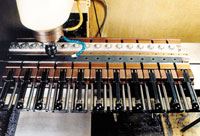Quick Action Vises
Vises are the workhorses of workholding. With innovations like the Plumb multi-flex CNC, the ubiquitous vise will continue to evolve as a useful tool for metalworking shops.
The precision machine vise is the most popular workholding device found in metalworking. Vises are versatile and economical. In part because vises have been around for such a long time, many may think they are a mature product with much of their development potential already accomplished.
Well, think again. Development of the vise continues. Shops are looking to the machine vise for more and more of the workholding chores. As job lot sizes become smaller, the economics of investing in dedicated fixtures is less favorable. Moreover, shorter product life cycles, with more frequent engineering changes on the parts that must be cut, add to the need for more workholding flexibility.
All this is making the vise more popular than ever, and vise manufacturers have responded with innovations such as machinable jaws that can hold asymmetrical blanks. Other innovations include high-density workholders that use a minimum amount of the machining center worktable to hold a maximum amount of part blanks.
Quick action vises are another recent innovation to help shops achieve a key productivity goal—better throughput. Most vises are actuated when an operator torques a screw that is attached to a movable jaw. As the screw is turned, it presses the workpiece blank against a stationary jaw. On multiple setups, where more than one vise is used, cranking five, six or eight vises can take some time. And with the operator manning the crank, there can be a problem of consistent torque being applied. Unless the operator uses a torque wrench, over torque or under torque can affect machining consistency from workpiece blank to blank.
Plumb multi-flex CNC vises represent a new wrinkle on the torquing problem. Made by Woodbury Devices, Inc., (Woodbury, Connecticut) these quick clamping, multiple jaw vises use a short throw lever action to actuate the clamping of a workpiece blank. When the lever is up, the vise is unclamped. Push the lever down and the jaws close with an adjustable clamping force of up to 2,000 pounds. Once clamping force is set, it remains consistent from part to part and operator to operator.
The basic design of the Plumb vise uses a master jaw that is bolted directly to the center T-slot of a vertical machining center. Stationary jaws mount on the front and back to this master rail. The stationary jaws are made in one piece for better repeatability. Like the master rail they attach to, these jaws extend in the X-axis direction the full length of the multi-station vise.
Two hardened steel rods pass through the stationary and master jaws covering the machining center worktable in the Y-axis direction. The movable jaws attach on either end of the rods and are able to move freely on the rods. Once the movable jaws are in place, keepers are secured to the back end of the rod, and the actuation mechanism goes on the front end of the rod. At this point the vise is ready for a workpiece blank.
The relative positions of the movable jaws, end keepers and actuation mechanism are fully adjustable. When the workpiece blank is in place, these components clamp to the bar and the vise is ready to go. A simple adjustment of the components on the rod allows quick accommodation of different size workpiece blanks.
Vises are the workhorses of workholding. With innovations like the Plumb multi-flex CNC, the ubiquitous vise will continue to evolve as a useful tool for metalworking shops.
Related Content
Custom Workholding Principles to Live By
Workholding solutions can take on infinite forms and all would be correct to some degree. Follow these tips to help optimize custom workholding solutions.
Read MoreIMTS Takeaways From the Modern Machine Shop Editorial Team
The first in-person IMTS in four years left the MMS editorial staff with a lot to digest. Here are a few of our takeaways from the show floor.
Read MoreModern Bar Feeds Bring New Life to Automatic Swiss Lathes
Cam-actuated Swiss lathes are still the fastest way to process many parts. By adding modern bar feeders, this shop has dramatically improved their utilization with the ability to work unattended, even in a lights-out environment.
Read MoreWhen To Use A Collet Chuck
Don't assume the standard chuck is the right workholding for every lathe application.
Read MoreRead Next
3 Mistakes That Cause CNC Programs to Fail
Despite enhancements to manufacturing technology, there are still issues today that can cause programs to fail. These failures can cause lost time, scrapped parts, damaged machines and even injured operators.
Read MoreThe Cut Scene: The Finer Details of Large-Format Machining
Small details and features can have an outsized impact on large parts, such as Barbco’s collapsible utility drill head.
Read More











.png;maxWidth=300;quality=90)
















